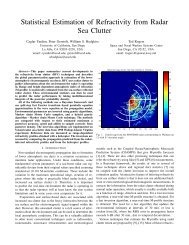Statistical Estimation and Tracking of Refractivity from Radar Clutter
Statistical Estimation and Tracking of Refractivity from Radar Clutter
Statistical Estimation and Tracking of Refractivity from Radar Clutter
Create successful ePaper yourself
Turn your PDF publications into a flip-book with our unique Google optimized e-Paper software.
17<br />
which results in the cancelation <strong>of</strong> the first term in (1.9). Therefore, to approximate<br />
the wave equation in this parabolic equation form the following conditions must<br />
be satisfied [14]:<br />
1. The equation is only valid within a narrow beam geometry called the paraxial<br />
cone, typically not more than 10 o . The first order error term associated with<br />
increased propagation angle is proportional to sin 4 α, where α is the angle<br />
between the propagation direction <strong>and</strong> the horizontal paraxial direction r.<br />
This error term will increase with α as 10 −7 , 10 −3 , <strong>and</strong> over 10 −2 for 1 o , 10 o ,<br />
<strong>and</strong> 20 o , respectively. More computationally expensive wider angle schemes<br />
can be implemented using the Padé coefficients however lower atmospheric<br />
duct calculations will typically require an angle less than 0.5 o (see Fig. 1.5)<br />
making the fast narrow angle code preferable to wide angle finite difference<br />
schemes.<br />
2. The field is valid only in the far-field, not close to the source.<br />
3. The medium is only weakly inhomogeneous such as the part-per-million<br />
changes involved here.<br />
4. Most <strong>of</strong> the energy should be propagating forward without any significant<br />
back scattering.<br />
Equation (1.17) can be marched using the split-step fast Fourier transform<br />
(FFT) method, where u(r, z) <strong>and</strong> U(r, p) are Fourier transform pair related by<br />
∫ zmax<br />
U(r, p) = F {u(r, z)} = u(r, z)e −jpz dz (1.21)<br />
−z max<br />
u(r, z) = F −1 {U(r, p)} = 1 ∫ pmax<br />
u(r, z)e jpz dp, (1.22)<br />
2π −p max<br />
where the transform variable is defined by p = k sin α, <strong>and</strong> the domain truncation<br />
height is related to p max using the Nyquist criteria z max p max = Nπ, N being the<br />
FFT size. Taking the FFT <strong>of</strong> the SPE (1.19) one can compute the closed form




